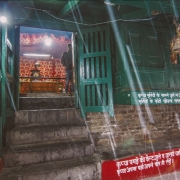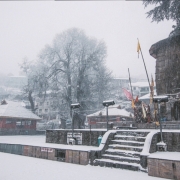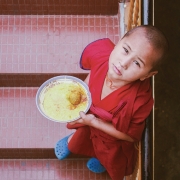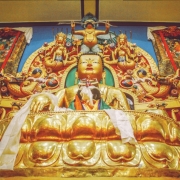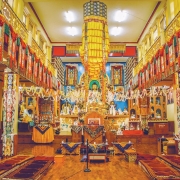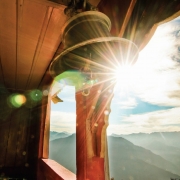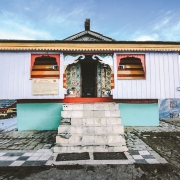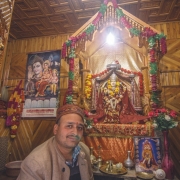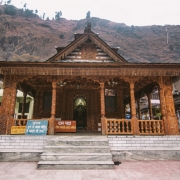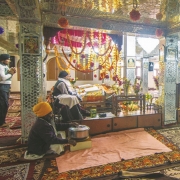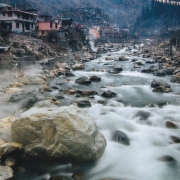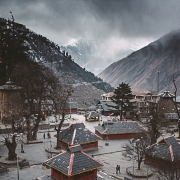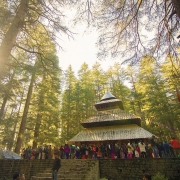
Etcetera
Travel; lifestyle; heritage and arts; books and miscellany

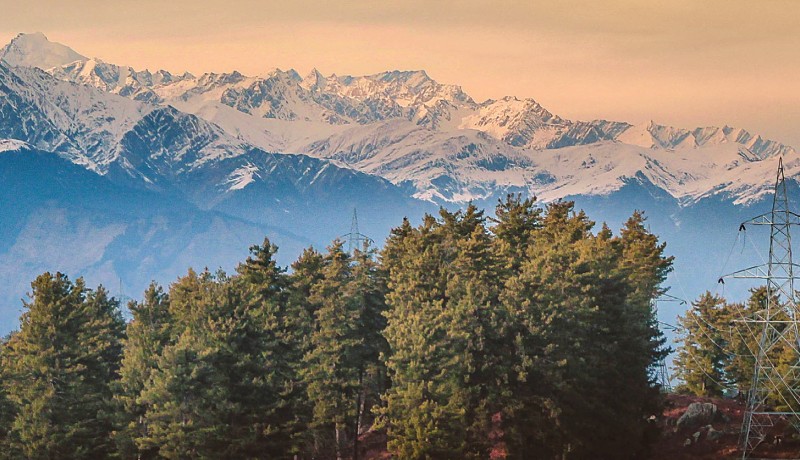
(2,133 m)
The humming little town of Bharmour or Brahmpura in the Budhil valley is spoken of as Shiva bhoomi or the abode of Lord Shiva. The looming Mani Mahesh temple (left, above) in the centre of the town enshrines a Shiva lingam, which is one in a galaxy of 84 smaller shrines in the Chaurasi Temple Complex (bottom). In the vicinity is a temple dedicated to Dharamraj or Lord Yama (left, below), the god of death. It is believed that every departed soul stands here to seek the permission of Dharamraj to enter Shiva loka. This court of Yama, where every departed soul is believed to glance back at his life and actions, is also called dhai podi, meaning two-and-a-half steps.
Getting there
Distance: 180 km from Pathankot and 60 km from Chamba
Transport: State transport bus or cab
(1,760 m)
Known for its hot springs (above), Manikaran, a resplendent town in Parvati Valley, is considered holy by both Hindus and Sikhs. Hindus believe Manu recreated human life in Manikaran after the flood. The temples on the banks of river Parvati house the deities of Rama, Krishna, Vishnu and Bhagwati (bottom right). The Naina Bhagwati temple (bottom centre) comes with a unique story. Legend has it that Parvati, Lord Shiva’s consort, lost her mani (jewel) in the river. When Shiva couldn’t find it, he grew enraged and opened his third eye. Naina Bhagwati was born of the wrath of Shiva’s third eye. It’s believed Shesh Nag, the snake god, helped recover the jewel by hissing, resulting in a flow of continuous boiling water, throwing up precious stones. Apparently, jewels continued to be thrown up in the waters until the earthquake of 1905.
While Shesh Nag’s hissing is credited with the hot springs, Sikhs believe Guru Nanak, the first of the 10 Sikh gurus, asked his disciple Bhai Mardana to lift a rock, from where the steaming waters of the hot springs gushed. The Manikaran Sahib Gurudwara (bottom left) uses this water to prepare its daily langar or Sikh communal meal. These two different stories about the origin of the hot springs are a reflection of the diversity of Indian culture.
Getting there
Distance: 42 km from Kullu
Transport: State transport bus or cab
(2,460 m)
Perched atop Mathan hill, Bijli Mahadev temple is a small temple that overlooks the Parvati and Kullu valleys. The 8th-century Pahari-style temple dedicated to Shiva is known for the 60-ft-high wooden staff (left) that looms large. It’s said the tall staff made of Deodar trunk attracts divine blessings in the form of lightning. Miraculously, the Shiva lingam that is shattered to pieces every time lightning strikes is restored by the priest using butter and sattu (gram flour)! Locals believe Lord Shiva absorbs the lightning to save us from the fury of nature. Hence, the name Bijli Mahadev.
Getting there
Distance: 26 km from Kullu and 3 km from Chansari
Transport: State transport bus or cab from Kullu; cab or a short hike from Chansari
(2,050 m)
In the middle of the Doongri Van Vihar is the Pagoda-roofed Hidimba Devi Temple, standing 24 m tall and adorned with timber tiles. Built in the 16th century, this temple is dedicated to demon goddess Hidimba, wife of Bhima, the Pandava prince. Though there is no deity in the temple—just a stone with a carved footprint—the carvings on the temple are replete with mythological motifs.
Getting there
Distance: 2.5 km from Manali
Transport: Take a cab or auto, or just walk it down
(1,800 m)
Not far from these centuries-old places of worship is the Dhakpo Shedrupling Monastery, built a mere 11 years ago on the banks of river Beas. Like other Tibetan monasteries, its serene old-world charm is inescapable. The monastery serves as a centre for the study of Buddhist philosophy.
Getting there
Distance: 10 km from Kullu
Transport: State transport bus or cab
Featured in Harmony — Celebrate Age Magazine December 2016
Small yet impactful choices can be game-changers, writes Srirekha Pillai At 102, there’s no stopping Chandigarh-based Man Kaur, the world’s….
While a regulatory framework is vital for senior-care facilities, the need of the hour is to develop an ecosystem to….
Published in a special edition to honour Japanese master storyteller Haruki Murakami’s 70th birthday, Birthday Girl (Penguin; Rs 100; 42….
Published as the revised and updated second edition, Incomparable Sachin Dev Burman (Blue Pencil; Rs. 599; 470 pages) the authoritative….

Harmony Celebrate Age
502 Plot No. 91/94
Prabhat Colony
Santacruz (East)
Mumbai – 400055

